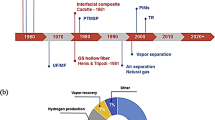Abstract
Liquid desiccant air-conditioning is an energy-efficient alternative to conventional vapor compression systems due to its ability to handle sensible and latent heat loads independently. Membrane-based processes are prevalent in desalination research due to their superior abilities to separate fluids. The membrane-assisted separation process is also suitable for use in liquid desiccant air-conditioning systems as it can minimize the problems of corrosion, which has so far prevented the widespread use of liquid desiccant systems. In this study, we have utilized the flat-sheet polytetrafluoroethylene membranes for liquid–vapor separation and combined multieffect design with vacuum conditions, for enhanced liquid–vapor separation across the membrane. Preliminary experiments and literature surveys indicate that the conventional vacuum multieffect membrane distillation system exhibits poor performance when the feed concentration is above 26%. Therefore, efforts are made to enhance its performance when operating at higher concentrations (30% and 34%) by employing flat-plate-type heat exchangers to preheat the liquid desiccant and by maintaining high air-side vacuum. The regeneration process can be optimized based on increase in concentration (ΔC) and performance ratio (PR), by controlling the operating conditions. The evaluations of the regenerator performance for different operating parameters including heat source temperature, circulation cross-flow rate are presented along with analysis. Preheating the LiCl solution before regeneration resulted in improved performance; PR of 0.58 and ΔC of 2.4% are achieved for 34% LiCl concentration.
Graphic abstract
Schematic representation of the membrane-assisted LDAC test bed











Similar content being viewed by others
References
Abdel-Salam AH, Ge G, Simonson CJ (2013) Performance analysis of a membrane liquid desiccant air-conditioning system. Energy Build 62:559–569
Abdel-Salam MR, Ge G, Fauchoux M, Besant RW, Simonson CJ (2014) State-of-the-art in liquid-to-air membrane energy exchangers (LAMEEs): a comprehensive review. Renew Sustain Energy Rev 39:700–728
AIL. Research INC. (n.d.). Patent No. 7,269,966. US
Bakhtiar A, Rokhman F, Choi KH (2012) A novel method to evaluate the performance of liquid desiccant air dehumidifier system. Energy Build 44:39–44
Bichowsky FR, Kelley GA (1935) Concentrated solutions in air-conditioning. Ind Eng Chem 27(8):879–882
Chen Q, Ja MK, Li Y, Chua KJ (2018) Thermodynamic optimization of a vacuum multi-effect membrane distillation system for liquid desiccant regeneration. Appl Energy 230:960–973. https://doi.org/10.1016/j.apenergy.2018.09.072
Choo FH, KumJa M, Zhao K, Chakraborty A, Dass ETM, Prabu M, Li B, Dubey S (2014) Experimental study on the performance of membrane based multi-effect dehumidifier regenerator powered by solar energy. Energy Procedia 48:535–542
Datta N, Chakraborty A (2016) Experimental investigation of a multi effect membrane based regenerator for high concentration aqueous LiCL solution as desiccant. In: Proceedings of the world congress on momentum, heat and mass transfer (MHMT’16), (页 ENFHT 111). Prague, Czech Republic. https://doi.org/10.11159/enfht16.111
Datta N, Chakraborty A, Ali SM, Choo FH (2017) Experimental investigation of multi-effect regenerator for desiccant dehumidifier: effects of various regeneration temperatures and solution flow rates on system performances. Int J Refrig 76:7–18
Dulac J, Abergel T, Delmastro C (2019) Tracking clean energy progress-building sector. International Energy Agency 检索日期: 2019,来源: https://www.iea.org/tcep/buildings/
Duong HC, Al-Jubainawi HA, He ZMT, Nghiem LD (2017) Liquid desiccant lithium chloride regeneration by membrane distillation for air conditioning. Sep Purif Technol 177:121–128
Emmott P (1965) A concentration-cell method for the determination of trace amounts of chloride in solutions of lithium salts. The Analyst 90(1073):482
Gommed K, Grossman G (2004) A liquid desiccant system for solar cooling and dehumidification. Sol Energy 126:879–885
Gommed K, Grossman G (2007) Experimental investigation liquid desiccant system for solar cooling and dehumidification. Sol Energy 81:131–138
Kiefer F, Schummer F, Präbst A, Spinnler M, Sattelmayer T (2017) Theoretical and experimental study of multi-effect vacuum membrane distillation systems for liquid desiccant air conditioning and zero liquid discharge. J Desal Water Treat 69:190–201. https://doi.org/10.5004/dwt.2017.20299
Lefers R, Bettahalli NS, Fedoroff N, Nunes SP, Leiknes T (2018) Vacuum membrane distillation of liquid desiccants utilizing hollow fiber membranes. Sep Purif Technol 199:57–63. https://doi.org/10.1016/j.seppur.2018.01.042
Liu XH (2004) Combined cogeneration and liquid-desiccant system applied in a demonstration building. Energy Build 36(9):945–953
Longo GA, Gasparella A (2005) Experimental and theoretical analysis of heat and mass transfer in a packed column dehumidifier/regenerator with liquid desiccant. Int J Heat Mass Transf 48:5240–5254
Mahmud K, Mahmood GI, Simonson CJ, Besant RW (2010) Performance testing of a counter-cross-flow run-around membrane energy exchanger (RAMEE) system for HVAC applications. Energy Build 42:1139–1147
Nimmo BG, Collier RK Jr, Rengarajan K (1993) Desiccant enhancement of cooling based dehumidification. ASHRAE Trans 99:842–848
Reyna JL, Chester MV (2017) Energy efficiency to reduce residential electricity and natural gas use under climate change. Nat Commun 8:1–12
Singh D, Sirkar KK (2014) High temperature direct contact membrane distillation based desalination using PTFE hollow fibers. Chem Eng Sci 116:824–833
Wang S, Wang Y (2016) Investigation of the through plane effective oxygen diffusivity in the porous media of PEM fuel cells: effects of the pore size distribution and water saturation distribution. Int J Heat Mass Transf 98:541–549
Wang J, Wu J, Wang H (2015) Experimental investigation of a dual-source powered absorption chiller based on gas engine waste heat and solar thermal energy. Energy 88:680–689
Yamaguchi S, Jeong J, Saito K, Miyauchi H, Harada M (2011) Hybrid liquid desiccant air-conditioning system: experiments and simulations. Appl Therm Eng 31:3741–3747
Zaytsev ID, Aseyev GG (1992) Properties of aqueous solutions of electrolytes. CRC Press, Boca Raton
Zuo J, Chung TS, OBrien GS, Kosar W (2017) Hydrophobic/hydrophilic PVDF/Ultem® dual-layer hollow fiber membranes with enhanced mechanical properties for vacuum membrane distillation. J Memb Sci 523:103–110
Acknowledgements
The authors would like to acknowledge financial support of the Natural Science Foundation of China (Nos. 51775348, U1637211).
Author information
Authors and Affiliations
Corresponding author
Additional information
Publisher's Note
Springer Nature remains neutral with regard to jurisdictional claims in published maps and institutional affiliations.
Rights and permissions
About this article
Cite this article
Datta, N., Zhuang, Z. & Qin, W. Experimental study of a liquid desiccant regeneration system: performance analysis for high feed concentrations. Clean Techn Environ Policy 22, 1255–1267 (2020). https://doi.org/10.1007/s10098-020-01851-w
Received:
Accepted:
Published:
Issue Date:
DOI: https://doi.org/10.1007/s10098-020-01851-w




